Alfa Romeo 4C 2016 Owner handbook (in English)
Manufacturer: ALFA ROMEO, Model Year: 2016, Model line: 4C, Model: Alfa Romeo 4C 2016Pages: 182, PDF Size: 9.49 MB
Page 91 of 182
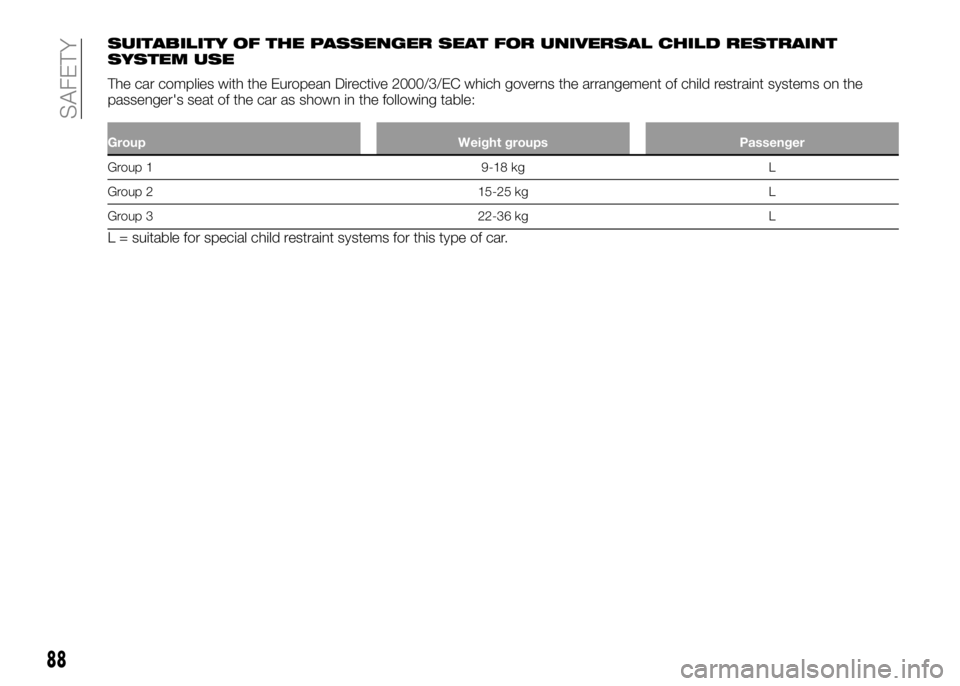
SUITABILITY OF THE PASSENGER SEAT FOR UNIVERSAL CHILD RESTRAINT
SYSTEM USE
The car complies with the European Directive 2000/3/EC which governs the arrangement of child restraint systems on the
passenger's seat of the car as shown in the following table:
Group Weight groups Passenger
Group 1 9-18 kg L
Group 2 15-25 kg L
Group 3 22-36 kg L
L = suitable for special child restraint systems for this type of car.
88
SAFETY
Page 92 of 182
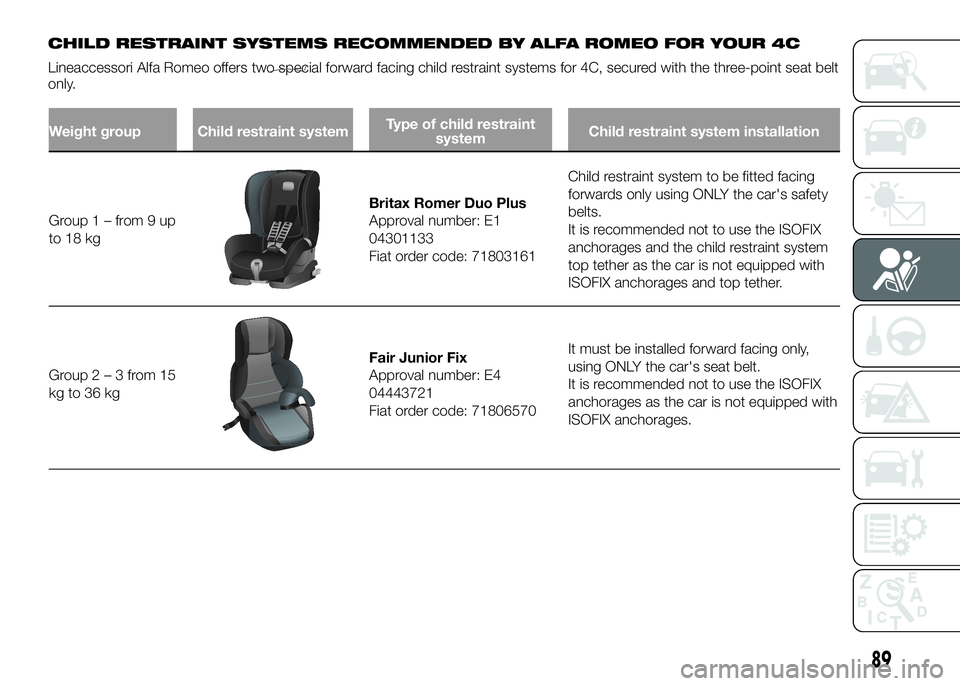
CHILD RESTRAINT SYSTEMS RECOMMENDED BY ALFA ROMEO FOR YOUR 4C
Lineaccessori Alfa Romeo offers two special forward facing child restraint systems for 4C, secured with the three-point seat belt
only.
89
Weight group Child restraint systemType of child restraint
systemChild restraint system installation
Group1–from9up
to 18 kg
Britax Romer Duo Plus
Approval number: E1
04301133
Fiat order code: 71803161Child restraint system to be fitted facing
forwards only using ONLY the car's safety
belts.
It is recommended not to use the ISOFIX
anchorages and the child restraint system
top tether as the car is not equipped with
ISOFIX anchorages and top tether.
Group2–3from15
kg to 36 kg
Fair Junior Fix
Approval number: E4
04443721
Fiat order code: 71806570It must be installed forward facing only,
using ONLY the car's seat belt.
It is recommended not to use the ISOFIX
anchorages as the car is not equipped with
ISOFIX anchorages.
Page 93 of 182
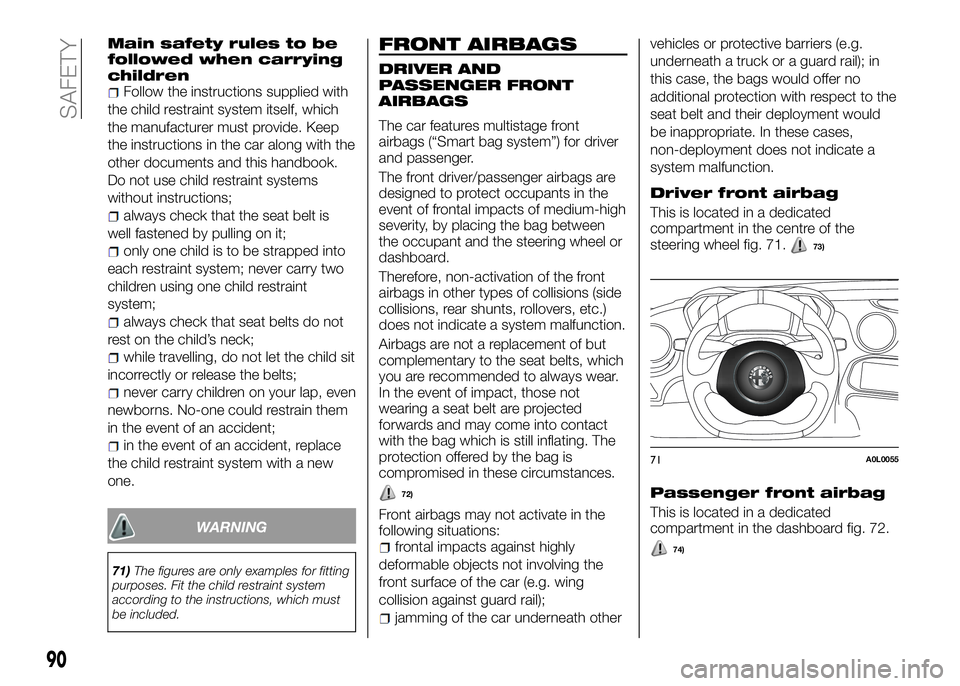
Main safety rules to be
followed when carrying
children
Follow the instructions supplied with
the child restraint system itself, which
the manufacturer must provide. Keep
the instructions in the car along with the
other documents and this handbook.
Do not use child restraint systems
without instructions;
always check that the seat belt is
well fastened by pulling on it;
only one child is to be strapped into
each restraint system; never carry two
children using one child restraint
system;
always check that seat belts do not
rest on the child’s neck;
while travelling, do not let the child sit
incorrectly or release the belts;
never carry children on your lap, even
newborns. No-one could restrain them
in the event of an accident;
in the event of an accident, replace
the child restraint system with a new
one.
WARNING
71)The figures are only examples for fitting
purposes. Fit the child restraint system
according to the instructions, which must
be included.
FRONT AIRBAGS
DRIVER AND
PASSENGER FRONT
AIRBAGS
The car features multistage front
airbags (“Smart bag system”) for driver
and passenger.
The front driver/passenger airbags are
designed to protect occupants in the
event of frontal impacts of medium-high
severity, by placing the bag between
the occupant and the steering wheel or
dashboard.
Therefore, non-activation of the front
airbags in other types of collisions (side
collisions, rear shunts, rollovers, etc.)
does not indicate a system malfunction.
Airbags are not a replacement of but
complementary to the seat belts, which
you are recommended to always wear.
In the event of impact, those not
wearing a seat belt are projected
forwards and may come into contact
with the bag which is still inflating. The
protection offered by the bag is
compromised in these circumstances.
72)
Front airbags may not activate in the
following situations:
frontal impacts against highly
deformable objects not involving the
front surface of the car (e.g. wing
collision against guard rail);
jamming of the car underneath othervehicles or protective barriers (e.g.
underneath a truck or a guard rail); in
this case, the bags would offer no
additional protection with respect to the
seat belt and their deployment would
be inappropriate. In these cases,
non-deployment does not indicate a
system malfunction.
Driver front airbag
This is located in a dedicated
compartment in the centre of the
steering wheel fig. 71.
73)
Passenger front airbag
This is located in a dedicated
compartment in the dashboard fig. 72.
74)
71A0L0055
90
SAFETY
Page 94 of 182
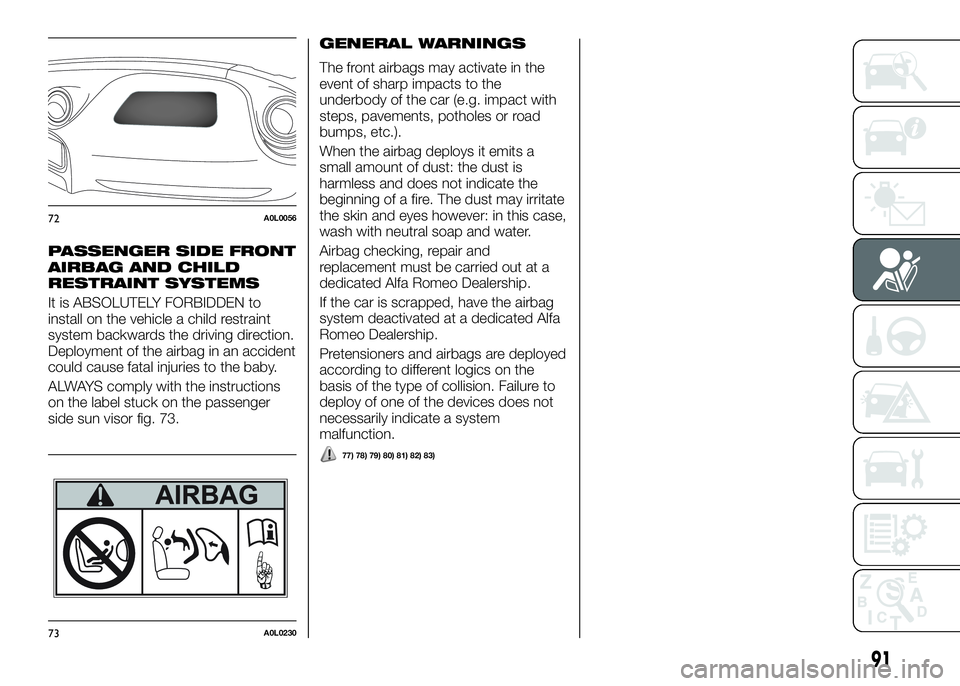
PASSENGER SIDE FRONT
AIRBAG AND CHILD
RESTRAINT SYSTEMS
It is ABSOLUTELY FORBIDDEN to
install on the vehicle a child restraint
system backwards the driving direction.
Deployment of the airbag in an accident
could cause fatal injuries to the baby.
ALWAYS comply with the instructions
on the label stuck on the passenger
side sun visor fig. 73.
GENERAL WARNINGS
The front airbags may activate in the
event of sharp impacts to the
underbody of the car (e.g. impact with
steps, pavements, potholes or road
bumps, etc.).
When the airbag deploys it emits a
small amount of dust: the dust is
harmless and does not indicate the
beginning of a fire. The dust may irritate
the skin and eyes however: in this case,
wash with neutral soap and water.
Airbag checking, repair and
replacement must be carried out at a
dedicated Alfa Romeo Dealership.
If the car is scrapped, have the airbag
system deactivated at a dedicated Alfa
Romeo Dealership.
Pretensioners and airbags are deployed
according to different logics on the
basis of the type of collision. Failure to
deploy of one of the devices does not
necessarily indicate a system
malfunction.
77) 78) 79) 80) 81) 82) 83)
72A0L0056
73A0L0230
91
Page 95 of 182
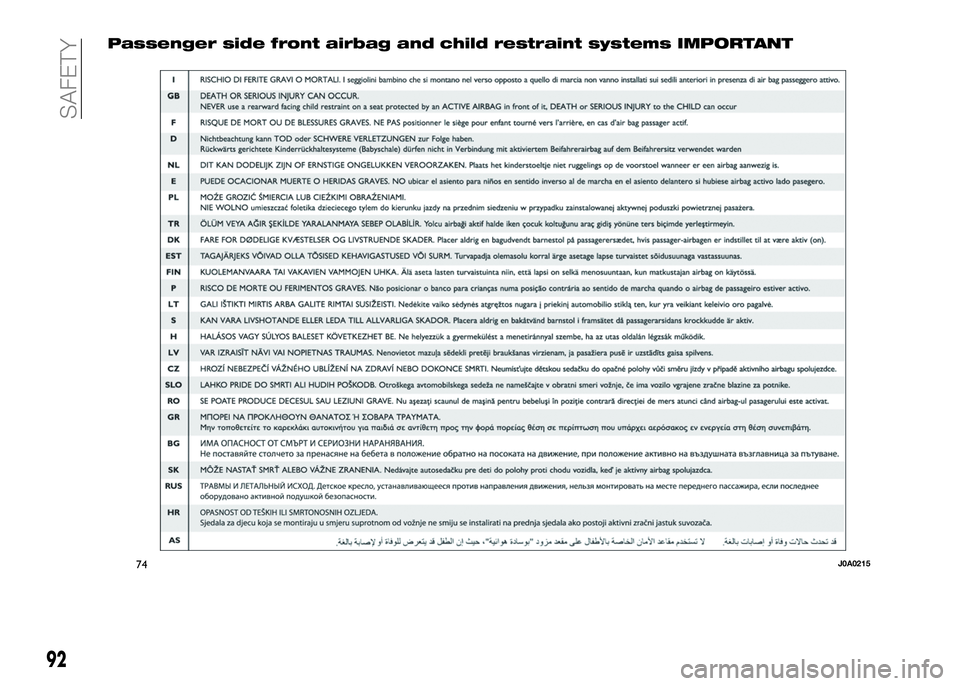
Passenger side front airbag and child restraint systems IMPORTANT
74J0A0215
92
SAFETY
Page 96 of 182
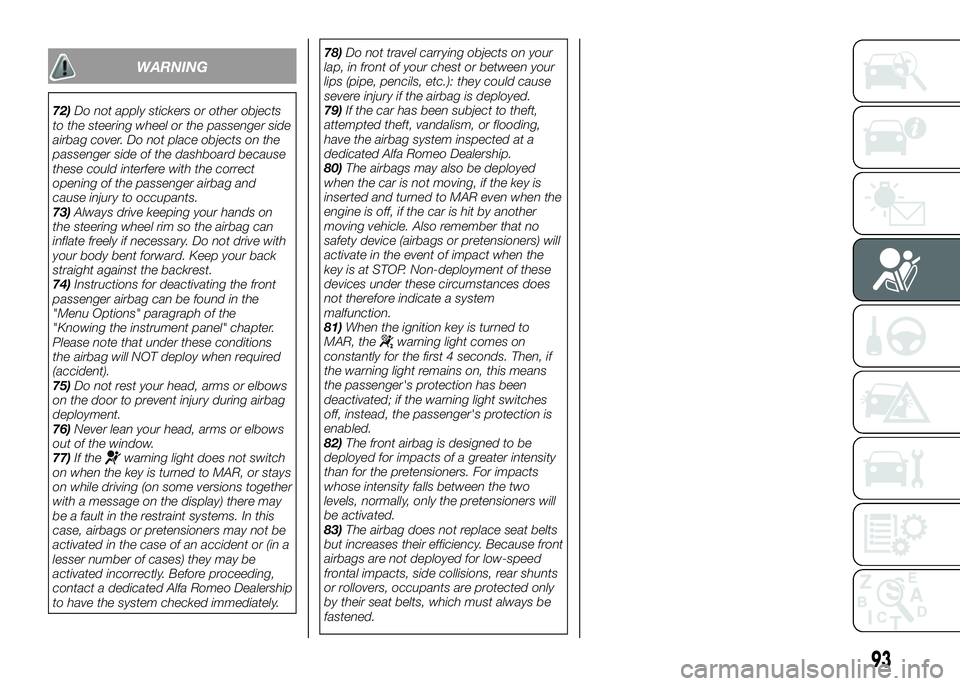
WARNING
72)Do not apply stickers or other objects
to the steering wheel or the passenger side
airbag cover. Do not place objects on the
passenger side of the dashboard because
these could interfere with the correct
opening of the passenger airbag and
cause injury to occupants.
73)Always drive keeping your hands on
the steering wheel rim so the airbag can
inflate freely if necessary. Do not drive with
your body bent forward. Keep your back
straight against the backrest.
74)Instructions for deactivating the front
passenger airbag can be found in the
"Menu Options" paragraph of the
"Knowing the instrument panel" chapter.
Please note that under these conditions
the airbag will NOT deploy when required
(accident).
75)Do not rest your head, arms or elbows
on the door to prevent injury during airbag
deployment.
76)Never lean your head, arms or elbows
out of the window.
77)If the
warning light does not switch
on when the key is turned to MAR, or stays
on while driving (on some versions together
with a message on the display) there may
be a fault in the restraint systems. In this
case, airbags or pretensioners may not be
activated in the case of an accident or (in a
lesser number of cases) they may be
activated incorrectly. Before proceeding,
contact a dedicated Alfa Romeo Dealership
to have the system checked immediately.78)Do not travel carrying objects on your
lap, in front of your chest or between your
lips (pipe, pencils, etc.): they could cause
severe injury if the airbag is deployed.
79)If the car has been subject to theft,
attempted theft, vandalism, or flooding,
have the airbag system inspected at a
dedicated Alfa Romeo Dealership.
80)The airbags may also be deployed
when the car is not moving, if the key is
inserted and turned to MAR even when the
engine is off, if the car is hit by another
moving vehicle. Also remember that no
safety device (airbags or pretensioners) will
activate in the event of impact when the
key is at STOP. Non-deployment of these
devices under these circumstances does
not therefore indicate a system
malfunction.
81)When the ignition key is turned to
MAR, the
warning light comes on
constantly for the first 4 seconds. Then, if
the warning light remains on, this means
the passenger's protection has been
deactivated; if the warning light switches
off, instead, the passenger's protection is
enabled.
82)The front airbag is designed to be
deployed for impacts of a greater intensity
than for the pretensioners. For impacts
whose intensity falls between the two
levels, normally, only the pretensioners will
be activated.
83)The airbag does not replace seat belts
but increases their efficiency. Because front
airbags are not deployed for low-speed
frontal impacts, side collisions, rear shunts
or rollovers, occupants are protected only
by their seat belts, which must always be
fastened.
93
Page 97 of 182
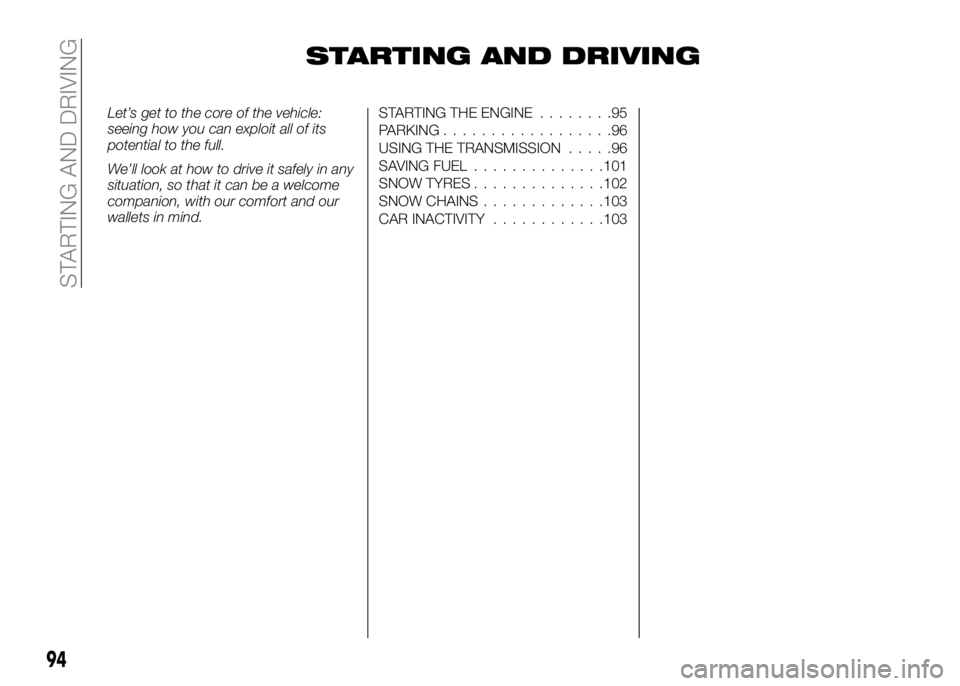
STARTING AND DRIVING
Let’s get to the core of the vehicle:
seeing how you can exploit all of its
potential to the full.
We’ll look at how to drive it safely in any
situation, so that it can be a welcome
companion, with our comfort and our
wallets in mind.STARTING THE ENGINE........95
PARKING..................96
USING THE TRANSMISSION.....96
SAVING FUEL..............101
SNOW TYRES..............102
SNOW CHAINS.............103
CAR INACTIVITY............103
94
STARTING AND DRIVING
Page 98 of 182
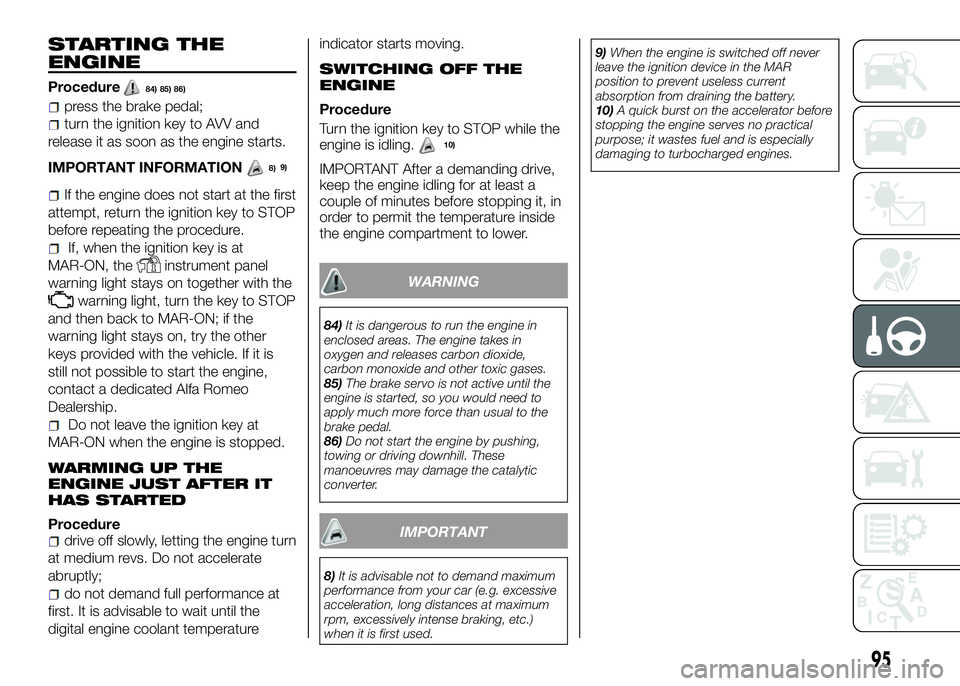
STARTING THE
ENGINE
Procedure84) 85) 86)
press the brake pedal;
turn the ignition key to AVV and
release it as soon as the engine starts.
IMPORTANT INFORMATION
9)
If the engine does not start at the first
attempt, return the ignition key to STOP
before repeating the procedure.
If, when the ignition key is at
MAR-ON, the
instrument panel
warning light stays on together with the
warning light, turn the key to STOP
and then back to MAR-ON; if the
warning light stays on, try the other
keys provided with the vehicle. If it is
still not possible to start the engine,
contact a dedicated Alfa Romeo
Dealership.
Do not leave the ignition key at
MAR-ON when the engine is stopped.
WARMING UP THE
ENGINE JUST AFTER IT
HAS STARTED
Proceduredrive off slowly, letting the engine turn
at medium revs. Do not accelerate
abruptly;
do not demand full performance at
first. It is advisable to wait until the
digital engine coolant temperatureindicator starts moving.
SWITCHING OFF THE
ENGINE
Procedure
Turn the ignition key to STOP while the
engine is idling.
IMPORTANT After a demanding drive,
keep the engine idling for at least a
couple of minutes before stopping it, in
order to permit the temperature inside
the engine compartment to lower.
WARNING
84)It is dangerous to run the engine in
enclosed areas. The engine takes in
oxygen and releases carbon dioxide,
carbon monoxide and other toxic gases.
85)The brake servo is not active until the
engine is started, so you would need to
apply much more force than usual to the
brake pedal.
86)Do not start the engine by pushing,
towing or driving downhill. These
manoeuvres may damage the catalytic
converter.
IMPORTANT
8)It is advisable not to demand maximum
performance from your car (e.g. excessive
acceleration, long distances at maximum
rpm, excessively intense braking, etc.)
when it is first used.9)When the engine is switched off never
leave the ignition device in the MAR
position to prevent useless current
absorption from draining the battery.
10)A quick burst on the accelerator before
stopping the engine serves no practical
purpose; it wastes fuel and is especially
damaging to turbocharged engines.
95
8)10)
Page 99 of 182
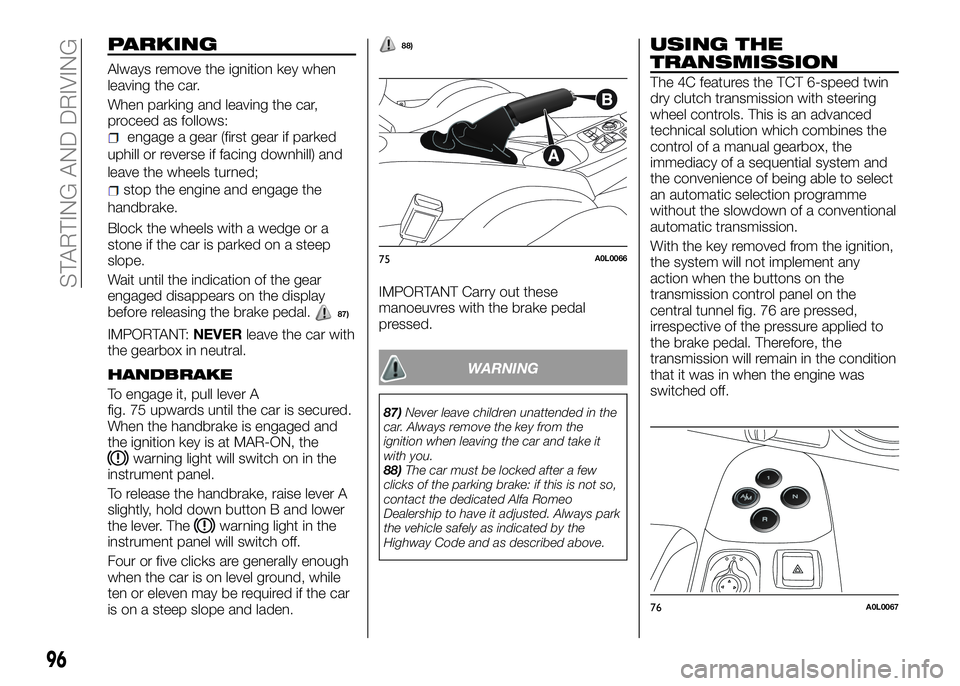
PARKING
Always remove the ignition key when
leaving the car.
When parking and leaving the car,
proceed as follows:
engage a gear (first gear if parked
uphill or reverse if facing downhill) and
leave the wheels turned;
stop the engine and engage the
handbrake.
Block the wheels with a wedge or a
stone if the car is parked on a steep
slope.
Wait until the indication of the gear
engaged disappears on the display
before releasing the brake pedal.
87)
IMPORTANT:NEVERleave the car with
the gearbox in neutral.
HANDBRAKE
To engage it, pull lever A
fig. 75 upwards until the car is secured.
When the handbrake is engaged and
the ignition key is at MAR-ON, the
warning light will switch on in the
instrument panel.
To release the handbrake, raise lever A
slightly, hold down button B and lower
the lever. The
warning light in the
instrument panel will switch off.
Four or five clicks are generally enough
when the car is on level ground, while
ten or eleven may be required if the car
is on a steep slope and laden.
88)
IMPORTANT Carry out these
manoeuvres with the brake pedal
pressed.
WARNING
87)Never leave children unattended in the
car. Always remove the key from the
ignition when leaving the car and take it
with you.
88)The car must be locked after a few
clicks of the parking brake: if this is not so,
contact the dedicated Alfa Romeo
Dealership to have it adjusted. Always park
the vehicle safely as indicated by the
Highway Code and as described above.
USING THE
TRANSMISSION
The 4C features the TCT 6-speed twin
dry clutch transmission with steering
wheel controls. This is an advanced
technical solution which combines the
control of a manual gearbox, the
immediacy of a sequential system and
the convenience of being able to select
an automatic selection programme
without the slowdown of a conventional
automatic transmission.
With the key removed from the ignition,
the system will not implement any
action when the buttons on the
transmission control panel on the
central tunnel fig. 76 are pressed,
irrespective of the pressure applied to
the brake pedal. Therefore, the
transmission will remain in the condition
that it was in when the engine was
switched off.
75A0L0066
76A0L0067
96
STARTING AND DRIVING
Page 100 of 182
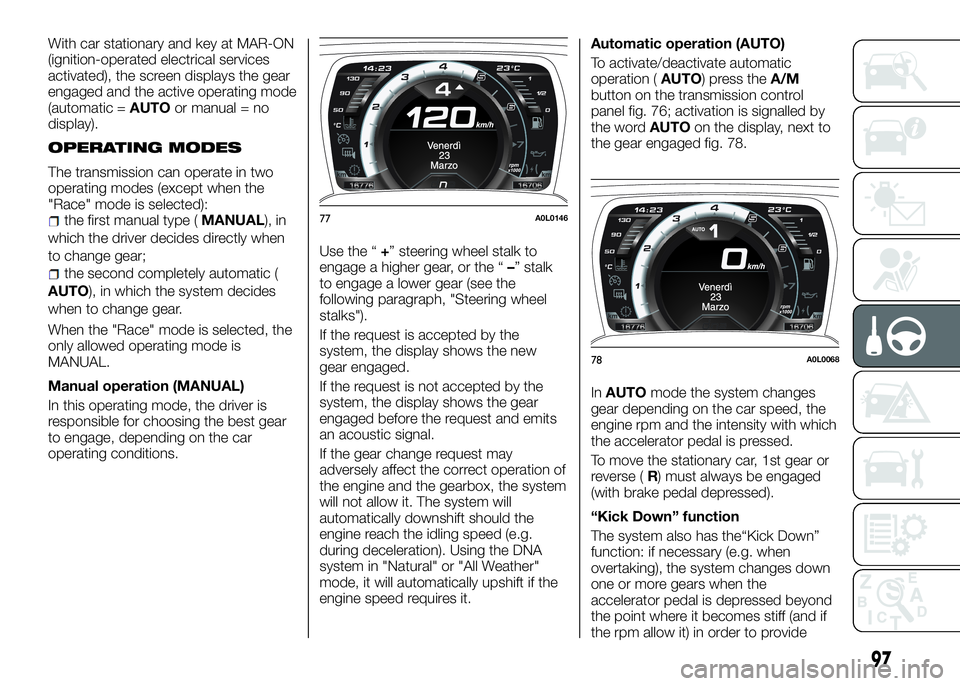
With car stationary and key at MAR-ON
(ignition-operated electrical services
activated), the screen displays the gear
engaged and the active operating mode
(automatic =AUTOor manual = no
display).
OPERATING MODES
The transmission can operate in two
operating modes (except when the
"Race" mode is selected):
the first manual type (MANUAL), in
which the driver decides directly when
to change gear;
the second completely automatic (
AUTO), in which the system decides
when to change gear.
When the "Race" mode is selected, the
only allowed operating mode is
MANUAL.
Manual operation (MANUAL)
In this operating mode, the driver is
responsible for choosing the best gear
to engage, depending on the car
operating conditions.Use the “+” steering wheel stalk to
engage a higher gear, or the “–” stalk
to engage a lower gear (see the
following paragraph, "Steering wheel
stalks").
If the request is accepted by the
system, the display shows the new
gear engaged.
If the request is not accepted by the
system, the display shows the gear
engaged before the request and emits
an acoustic signal.
If the gear change request may
adversely affect the correct operation of
the engine and the gearbox, the system
will not allow it. The system will
automatically downshift should the
engine reach the idling speed (e.g.
during deceleration). Using the DNA
system in "Natural" or "All Weather"
mode, it will automatically upshift if the
engine speed requires it.Automatic operation (AUTO)
To activate/deactivate automatic
operation (AUTO) press theA/M
button on the transmission control
panel fig. 76; activation is signalled by
the wordAUTOon the display, next to
the gear engaged fig. 78.
InAUTOmode the system changes
gear depending on the car speed, the
engine rpm and the intensity with which
the accelerator pedal is pressed.
To move the stationary car, 1st gear or
reverse (R) must always be engaged
(with brake pedal depressed).
“Kick Down” function
The system also has the“Kick Down”
function: if necessary (e.g. when
overtaking), the system changes down
one or more gears when the
accelerator pedal is depressed beyond
the point where it becomes stiff (and if
the rpm allow it) in order to provide
77A0L0146
78A0L0068
97